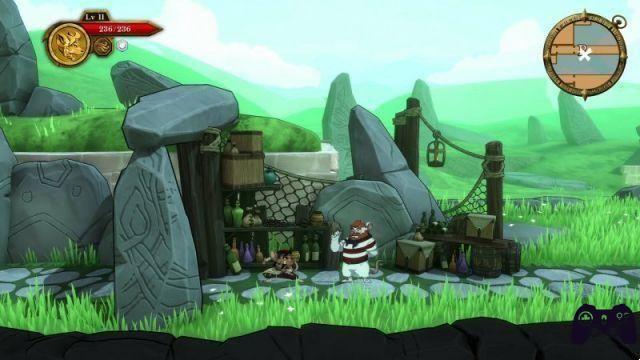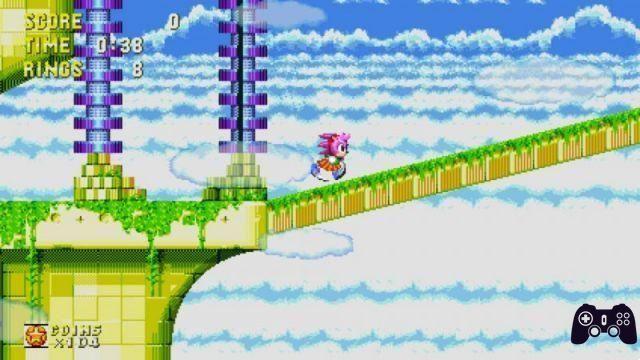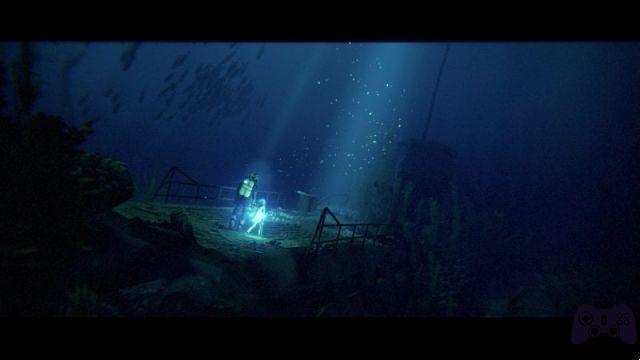Pronounced by architect Peter Behrens and later become the workhorse of his protégé Ludwig Mies van der Rohe, "less is more" is the paradigm of modern design. Clean lines, forms applied to function, minimalism as intention and result. A concept that clearly goes beyond the limits of architecture and can be applied to any form of design, even gaming. This is the case of The Last Clockwinder, a small pearl developed by dotco and that in 2022 it was chosen as the best title in the Meta Quest store. Seeing the port of this splendid puzzle adventure to PlayStation VR2 can only make us happy, because we are talking about a title that maximizes the potential of virtual reality, and for just under €25 you cannot miss it. We explain why in ours review of The Last Clockwinder for PS VR2.
It begins with a narrative.

The last watchmaker is a'puzzle adventure in first person, in which the player assumes the role of Jules, a scientist who returns to her childhood home to prevent a catastrophe. The Clock Tower is a gigantic alien tree, in which all the plant seeds scattered throughout the universe are stored, a bit like our world seed bank on the Svalbard Islands. The Tower is constantly watched by a human guardian and a host of robotic gardeners. Inexplicably, one day the Tower begins to sink and the guardian, Edea, a woman who raised and educated the protagonist and her adventure companion Levi, disappears. During the adventure, the player will move through the countless rooms of the Tower... or rather: there is always only one room but its floor is connected to a platform system. In the right corner of the main room there is a console with a world map, from where it is possible to recall the different "rooms" of the Tower at will.
This is one of the many ideas that demonstrate The Last Clockwinder's minimalism, as well as the choice to tell a moving story with indirect narrative devices. For the purposes of the gaming experience, the narrative part It's not strictly necessary because we're still talking about a puzzle-based game, where the fulcrum of the action is solving the puzzles. However, in the different rooms of the Tower it is possible to find old recordings of Edea, made during Jules' stay in the Tower during his childhood. Only the voices of the two women will always tell the story, along with the various communications that the protagonist maintains with her partner Levi, who monitors her from an orbiting spaceship. There are no non-player characters, scenes, or extensive maps to navigate. The Last Clockwinder confines the action within a intimate space and tight but never suffocating, in which the player is free to move and explore to complete the tasks in each room.
Game mechanics

The pace at which the adventure progresses in The Last Clockwinder is calibrated and precise, almost emulating the way clocks keep time. From this point of view, the notions that the player must learn are very few. You can only change rooms if you have the corresponding key, small tokens left here and there in different rooms, and to use the device you will need to consume energy. The Tower can extract it from Facilities They are kept inside, so the rooms are fundamentally divided into two types: collection rooms and assembly rooms. In the harvest rooms, the player must plant the seeds in pots, collect the fruits and transport them to a pneumatic device. Obviously, doing just this extremely mechanical job requires a lot of time and effort, and here comes the queen mechanic on which The Last Clockwinder relies, namely the movement cloning.

At the beginning, Jules will pick up a special pair of gloves: pressing the buttons on the left controller will launch a record which will track the player's movements for a few seconds. Once the time has passed, a mechanical gardener will be automatically created, which will endlessly emulate the movement we just imitated. Therefore, puzzle solving takes shape rather on the problem-solving spectrum, where the goal is to create a robotic assembly line from a sentient human action. The same should be done in the assembly rooms, where it will always be necessary to plant the seeds in the pots and collect the fruits, but the instructions on the blackboards in the individual rooms must be followed later. In fact, different fruits can be assembled into structures that replicate the shape of the molecules, using sticks. The player can never grab them directly, but you can only stick them into a fruit while holding it in your hand. Once the structure is assembled, it will be placed in a press that will return gems, which can be spent to purchase other seeds.

The further the adventure progresses, the more variety of fruits available: we will start with a hybrid between an apple and a tomato, gradually discovering many other strange plants. Being exotic species, each fruit or vegetable will behave differently: pumpkins, for example, will float and giant blueberries cannot be held in your hand for too long, otherwise they will sublimate into gas. Therefore, each plant introduces different variations and unknowns and it will be up to the player to understand how to manipulate them and with what criteria to create the most efficient assembly line. In fact, it goes without saying that each room has a series of records to beat, where the final objective is obviously to achieve the highest production quota with the smallest number of gardeners. The funny thing is that once put to work, gardeners will continue working even if the room they are working in is not the active one. In fact, the action of the robots continues in the background and allows you to accumulate a large amount of fruits and seeds. Part of the beauty of The Last Clockwinder is seeing the Tower's productivity increase dramatically, even as the player engages in other activities. This is also very important in the final phases, where the fruit quota necessary to feed the platforms, and therefore call new rooms from the control system, becomes especially expensive.

I wish we could tell you that we have much more to tell you about The Last Clockwinder but in reality Pontoco's title ends here, and at the same time it never ends. A unique idea at the service of a gameplay that is enriched as the adventure progresses, demanding the player brilliant and effective solutions. And if you are a perfectionist, you will realize that even the most ingenious solution always has room for improvement, which in the best of cases could push you to replace a robot with one with more fluid and faster movements, and in the worst case. will prompt you to eliminate it. all your gardeners, who can be removed from their position at any time, to start again.
PS VR2 game modes and controls

Although at first glance The Last Clockwinder seems like a very basic game in appearance, in reality when you play it you realize the technical success of the title. Beyond the graphical impact, which in PS VR2 obviously gains in brightness and resolution but which, it must be said, is also extremely pleasant in Half Quest 2, what works particularly well is the hand and movement tracking. From time to time you will see our robotic gardeners making turns that are not exactly fluid to look at, but the precision with which the player's hand movements are recorded is remarkable and, we must add, could not happen any other way. the type of game. Very often, being one step further to the right or left of a vase can make the difference, just as the trajectory of a shot can be decisive. We didn't say it, we took it for granted, but gardeners can touch, pass or throw away all the fruits and vegetables found in both the picking and assembly rooms. And that's why precision and freedom of movement are crucial to creating the perfect assembly line.
The title can be enjoyed on PS VR2 from both seated as vertical, without the need for whole room mode, since the player is only supposed to move his hands and arms to impart movements to the fielders, always remaining still in his place. It was almost impossible for us to play the title in its final phases sitting down, because to solve some rooms we felt the need to have full mobility of the trunk and limbs. Movement can be free, using the right PlayStation VR2 Sense analog stick, or with teleportation. From this point of view, we would have liked to see the same solution adopted by the recent Maskmaker, where the two movement systems can be used simultaneously and assigned to the two analog sticks of the controllers, to manage macro movements with teleportation and small adjustments of position with free movement.

Another technical aspect that should not be underestimated is the amount of elements present on the screen. There are times when the rooms will be especially crowded, with more than a dozen gardeners picking, throwing and grabbing fruit and structures. Part of the complexity of the game is also not getting in the way of the other gardeners, exploiting all possible creative solutions. A truly elegant detail is the correlation between action and colonna sonora: When you first enter a room, there is silence and there is no accompaniment. When the first gardener is replicated, a light musical carpet begins to be heard in the background, and the more gardeners get to work, the greater the number of instruments that add to the symphony.
Conclusions
Tested version PlayStation 5, PC con Windows digital delivery PlayStation Store Price 24,99 € Holygamerz.com 9.0 Readers (7) 7.4 your voteThe Last Clockwinder is one of those rare gems that, thanks to a solid and simple idea, manages to demonstrate the potential of virtual reality. Characterized by a minimalism that is always intelligent but never aseptic, Pontoco's puzzle adventure manages to entertain for several hours. It is difficult to estimate the duration of a puzzle title, which obviously varies depending on the player's preparation, but if we went too far we would estimate it between six and eight hours. A duration that depends not only on logical ability, but also on how much you want to delve into the story, told by only three narrators and yet full of feeling and sweetness. Don't let yourself be stopped by the lack of localization in Spanish, or by prejudice regarding the type of title: The Last Clockwinder can entertain anyone. We fell in love and hope that the Clock Tower welcomes many more guardians.
PRO
- Minimalist but bright
- Auxiliary but well thought out narrative.
- Technically solid
AGAINST
- More freedom to choose how to move
- Some animations are not very fluid.






